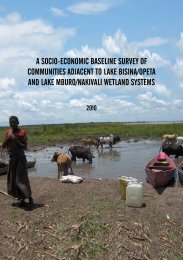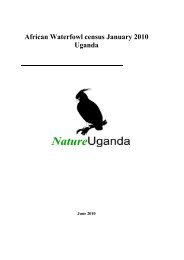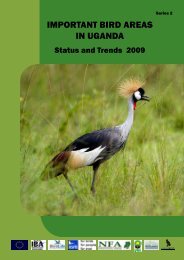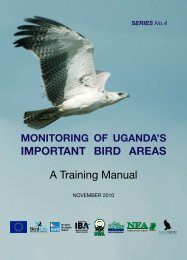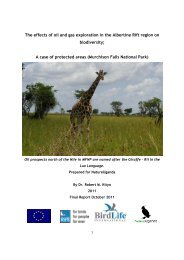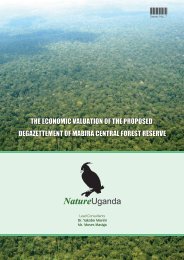A Ecological Baseline Surveys Of: - Lake Bisina - Nature Uganda
A Ecological Baseline Surveys Of: - Lake Bisina - Nature Uganda
A Ecological Baseline Surveys Of: - Lake Bisina - Nature Uganda
Create successful ePaper yourself
Turn your PDF publications into a flip-book with our unique Google optimized e-Paper software.
3.4.1 Species Richness<br />
There were at least four forest edge/woodland species recorded from the two Nakivale sites and<br />
<strong>Bisina</strong> 2 transects. These were Bicyclus jefferyi, Precis pelarga, Ypthima albida and Ypthimomorpha<br />
itonia. There was one FL species recorded from Nakivale 2 (B. smithi). There were four swamp/<br />
wetland species recorded during this study. These included Acraea rahira (Opeta 1), Mylothris<br />
rubricosta (Nakivale 2), Borbo micans (<strong>Bisina</strong> 3) and Metisella midas (Nakivale 2).<br />
Table 1. Summary of Ecotypes for the three Ramsar sites<br />
Ecotype <strong>Lake</strong> Nakivale <strong>Lake</strong> <strong>Bisina</strong> <strong>Lake</strong> Opeta<br />
FL 1 0 0<br />
f. 2 1 0<br />
S 2 1 1<br />
O 3 11 5<br />
W 11 16 9<br />
O/m 2 8 4<br />
W/m 2 5 4<br />
U 0 1 0<br />
Total 23 43 23<br />
From table 1, it can be noted that the majority of the species recorded at all the three sites fall in the<br />
widespread and open habitat categories. <strong>Lake</strong> <strong>Bisina</strong> registered the highest number of species with<br />
<strong>Lake</strong> Nakivale and <strong>Lake</strong> Opeta with 23 species of butterflies respectively.<br />
Figure 1. Distribution of butterfly species in the three study sites<br />
Different butterfly species have varied ecological preferences within the habitats. For the wetland<br />
systems, the swamp/wetland species (S) is an indicator of the quality of the habitat. From figure<br />
1, the majority of species recorded were open habitat species and the widespread species. The<br />
Nakivale area surveyed was dominated by the Acacia woodland and reason enough to justify the<br />
presence of a forest species.<br />
In comparison with previous studies (Asasira, 2003), a number of species which were recorded<br />
then were visibly absent from current study. For <strong>Lake</strong> <strong>Bisina</strong>; Asasira (2003) recorded a total of 61<br />
species compared with 43 species from this study. Like for <strong>Lake</strong> Opeta, there was a reduction in<br />
species numbers from 73 species to only 23 species.<br />
<strong>Ecological</strong> <strong>Baseline</strong> <strong>Surveys</strong> of <strong>Lake</strong> <strong>Bisina</strong>, <strong>Lake</strong> Opeta, <strong>Lake</strong> Mburo and Nakivali Wetlands Systems 45



